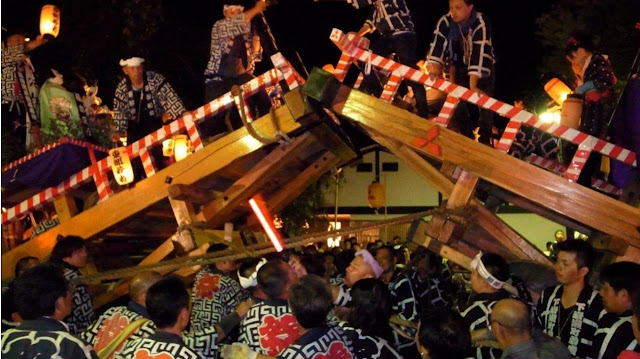イカドウの形
イカ籠(イカドウ)の形 Ikado Fishing Device for Squid Fishing
千葉県木更津の金田漁港では複数のイカドウ形態を見ることができます。民具形態に興味を持つ人にとっては宝庫のようなエリアでしょう。それらの形態を特徴付けるメインフレーム(アーチ状フレーム)が竹製のこの中では最古と思われる“ 初代”イカドウ,その竹フレームが金属に置き換えられても開閉・折り畳み機構は初代と同じである2代目と,すべてのフレームが剛結合された3代目が集まっています。
At Kaneda fishing port in Kisarazu, Chiba Prefecture, a device known in Japanese as an ikado, which is a kind of traditional squid fishing used in Tokyo Bay, can be seen. This area, along with other local areas where historical artifacts have survived, is a treasure trove for people interested in folk tool forms.
There are three types of ikado : the first generation, whose main frame is made of bamboo, and which is considered to be the oldest of these; the second generation, in which the bamboo frame of the first generation has been replaced by metal but whose opening and folding mechanism is the same as that of the first generation; and the third generation, in which all the frames are made of metal and are rigidly connected to each other so that the interesting opening mechanism that the earlier generations demonstrated and the traditional form that they exhibited have been lost. But the development of the forms seems to demonstrate a better adaptation, or even optimal adaptation, to the conditions of each era.
イカ籠(イカドウ)の形 Ikado Fishing Device for Squid Fishing
千葉県木更津の金田漁港では複数のイカドウ形態を見ることができます。民具形態に興味を持つ人にとっては宝庫のようなエリアでしょう。それらの形態を特徴付けるメインフレーム(アーチ状フレーム)が竹製のこの中では最古と思われる“ 初代”イカドウ,その竹フレームが金属に置き換えられても開閉・折り畳み機構は初代と同じである2代目と,すべてのフレームが剛結合された3代目が集まっています。
At Kaneda fishing port in Kisarazu, Chiba Prefecture, a device known in Japanese as an ikado, which is a kind of traditional squid fishing used in Tokyo Bay, can be seen. This area, along with other local areas where historical artifacts have survived, is a treasure trove for people interested in folk tool forms.
There are three types of ikado : the first generation, whose main frame is made of bamboo, and which is considered to be the oldest of these; the second generation, in which the bamboo frame of the first generation has been replaced by metal but whose opening and folding mechanism is the same as that of the first generation; and the third generation, in which all the frames are made of metal and are rigidly connected to each other so that the interesting opening mechanism that the earlier generations demonstrated and the traditional form that they exhibited have been lost. But the development of the forms seems to demonstrate a better adaptation, or even optimal adaptation, to the conditions of each era.
the first generation of ikado
the second (upper) and the third generation (lower)
1. イカ網漁とイカ籠漁 Squid net fishing and squid basket fishing
まずは東京湾でのイカ漁の状況を浦安市郷土博物館にて開催された企画展「東京湾のイカ網漁」から読み解いてい見たいと思います。
Let's start with the exhibition "Squid Net Fishing in Tokyo Bay" held at the Urayasu City Museum in Chiba, 2017.
浦安のイカ網漁ジオラマ
Urayasu Squid Net Fishing Diorama
当時に雰囲気がよく掴める楽しいジオラマでした。網の張り具合もリアリティがあり,技術のいる漁法であったことが理解できます。
The diorama was a fun way to capture the atmosphere of the time. The netting was realistic and shows the skill required for fishing squid.
イカ網で引き上げるイカ藻 ここに産卵のためにイカが集まる
Pseudo-algal artifacts ikamo that squid prefer during spawning which were pulled up in a squid net with squids, squids gather here to spawn
このイカ網漁では,イカ藻すくい上げることは難しく,イカ藻状のものを内装するイカ籠(イカドウ)を用いた漁法に変化していったようです。確かにこの方法ではイカ藻の回りをウロウロするイカは,近づく漁網から逃げるでしょう,よほどのスピード感をもって網を引き寄せないと残されたイカ藻のみが引き上げられることになりそうです。
In this squid net fishing, it was difficult to scoop up the cylindrical devices called ikamo, so the fishing method seems to have changed to using squid baskets called ikado in which the ikamo were installed inside. It may be true that in this previous method, the squids wandering around the squid algae would escape from the approaching fishing net, and unless the net was drawn in with great speed, only the remaining ikamo would be pulled up.
そのために,イカ藻を内包する籠つまりイカ籠・イカドウを使用するようになったようです。でも,籠を使わない方法にはイカとの直接的な知恵比べが伺えて,大変な中でワクワクするものであったかもしれません。
イカ籠のスケッチ, 企画展「東京湾のイカ網漁」,浦安市郷土博物館,2017より
Squid basket sketch, from the exhibition "Squid net fishing in Tokyo Bay", Urayasu City Museum, 2017
今回はこのイカドウの形に注目してみたいと思います。その形の特徴はオームのようなツチノコのようなずんぐりした外形であること以上に,この籠が収納時には面白ぐらい平たく畳まれるところにあります。詳細は後で説明してみたいと思いますが,手に入れやすい素材と,その素材の性質を本当にうまく使いこなし,無駄なく自然に,そしてダイナミックに構成された形の一つであると感じています。
In this issue, I would like to focus on the shape of this ikado. Its shape is characterized not only by its stocky exterior, like the Ohm in the movie ‘Naushika of the Valley of the Wind’, or the legendary animal Tsuchinoko of the Chugoku Mountains in Japan, but also by the fact that this basket folds up interestingly flat when stored. As will be explained in more detail later, I feel that this is one of those forms which are constructed naturally and dynamically, without waste, by making good use of familiar materials and their characteristics.
旧型イカドウ the first generation of ikado
実は2つのイカドウが重なっている。1つのイカドウは折りたたまれており,その厚みをほとんど感じさせない。鉄パイプが2本あることが,ここに2体のイカドウがあることを示している。
There are actually two overlapping ikado, one of which is folded over, giving little indication of its thickness. The presence of two iron pipes in the picture indicates that there are two ikado there.
中央の鉄パイプが目立ってしまいますが,そのパイプは錘であり,イカドウのメインフレームはその下の長軸方向に延びる割竹と,同じリズムで曲げられた曲げ竹フレームのようです。
The central iron pipes are conspicuous, but those pipes are just weights, and the main frame of the ikado is composed of some short, bent bamboo frames, which are bent in a way which generates elasticity like the feature of the misaki in the case of the winnowing basket, and the longitudinally split bamboo extending along the longitudinal axis below the iron pipe.
下面の縁を楕円状に竹が周り,あわせて7本の竹フレームがそれぞれの両端のみが回転支持された状態で立体構成されています。半壊している同じ旧型のイカドウを触ってみると,この竹フレームすべて回転可能であり,中央部に連続して通された細いロープをほどくことで,この網立体は簡単にぺちゃんこになることが簡単に想像できます。
そして,この画像ではそう見えにくいのですが,胴体の両側に穴が開いています。比較的新しいイカドウになると,輪っかがついています。この穴からイカは内部に入り込み,イカ藻に産卵し,そして出られなくなっていたのでしょう。
金属フレームのイカドウ
金属フレームのイカドウと旧型の竹フレームのイカドウのカゴとしての形に大きな違いは見られませんが,竹フレームがもつ完全折り畳み機能は,どうも必要とされなくなってきていたようで,かつての可動部も完全に固定されている様子も見えました。おそらく,船の大きさに伴い,昔のような完璧なまでの収納性は必要とされなくなってきたのでしょうか。また,イカドウ特有の形状は維持されてはいるものの,長竹を曲げることで必然的に形成されていた形状ではなく,単に,おそらく慣習的に,竹イカドウに似曲げ鉄フレームを適用したようにも見えます。その表れとして,さらに新しいと思われるイカドウは,完全に直方体のカゴそのものになっていることが上の写真でも分かります。こうなってしまうとかつての収納名人の技は完全に失われるわけです。
the first generation of ikado
the second (upper) and the third generation (lower)
1. イカ網漁とイカ籠漁 Squid net fishing and squid basket fishing
まずは東京湾でのイカ漁の状況を浦安市郷土博物館にて開催された企画展「東京湾のイカ網漁」から読み解いてい見たいと思います。
Let's start with the exhibition "Squid Net Fishing in Tokyo Bay" held at the Urayasu City Museum in Chiba, 2017.
浦安のイカ網漁ジオラマ
Urayasu Squid Net Fishing Diorama
当時に雰囲気がよく掴める楽しいジオラマでした。網の張り具合もリアリティがあり,技術のいる漁法であったことが理解できます。
The diorama was a fun way to capture the atmosphere of the time. The netting was realistic and shows the skill required for fishing squid.
イカ網で引き上げるイカ藻 ここに産卵のためにイカが集まる
Pseudo-algal artifacts ikamo that squid prefer during spawning which were pulled up in a squid net with squids, squids gather here to spawn
このイカ網漁では,イカ藻すくい上げることは難しく,イカ藻状のものを内装するイカ籠(イカドウ)を用いた漁法に変化していったようです。確かにこの方法ではイカ藻の回りをウロウロするイカは,近づく漁網から逃げるでしょう,よほどのスピード感をもって網を引き寄せないと残されたイカ藻のみが引き上げられることになりそうです。
In this squid net fishing, it was difficult to scoop up the cylindrical devices called ikamo, so the fishing method seems to have changed to using squid baskets called ikado in which the ikamo were installed inside. It may be true that in this previous method, the squids wandering around the squid algae would escape from the approaching fishing net, and unless the net was drawn in with great speed, only the remaining ikamo would be pulled up.
そのために,イカ藻を内包する籠つまりイカ籠・イカドウを使用するようになったようです。でも,籠を使わない方法にはイカとの直接的な知恵比べが伺えて,大変な中でワクワクするものであったかもしれません。
イカ籠のスケッチ, 企画展「東京湾のイカ網漁」,浦安市郷土博物館,2017より
Squid basket sketch, from the exhibition "Squid net fishing in Tokyo Bay", Urayasu City Museum, 2017
今回はこのイカドウの形に注目してみたいと思います。その形の特徴はオームのようなツチノコのようなずんぐりした外形であること以上に,この籠が収納時には面白ぐらい平たく畳まれるところにあります。詳細は後で説明してみたいと思いますが,手に入れやすい素材と,その素材の性質を本当にうまく使いこなし,無駄なく自然に,そしてダイナミックに構成された形の一つであると感じています。
旧型イカドウ
実は2つのイカドウが重なっている。1つのイカドウは折りたたまれており,その厚みをほとんど感じさせない。鉄パイプが2本あることが,ここに2体のイカドウがあることを示している。
中央の鉄パイプが目立ってしまいますが,そのパイプは錘であり,イカドウのメインフレームはその下の長軸方向に延びる割竹と,同じリズムで曲げられた曲げ竹フレームのようです。下面の縁を楕円状に竹が周り,あわせて7本の竹フレームがそれぞれの両端のみが回転支持された状態で立体構成されています。半壊している同じ旧型のイカドウを触ってみると,この竹フレームすべて回転可能であり,中央部に連続して通された細いロープをほどくことで,この網立体は簡単にぺちゃんこになることが簡単に想像できます。
そして,この画像ではそう見えにくいのですが,胴体の両側に穴が開いています。比較的新しいイカドウになると,輪っかがついています。この穴からイカは内部に入り込み,イカ藻に産卵し,そして出られなくなっていたのでしょう。
金属フレームのイカドウ
金属フレームのイカドウと旧型の竹フレームのイカドウのカゴとしての形に大きな違いは見られませんが,竹フレームがもつ完全折り畳み機能は,どうも必要とされなくなってきていたようで,かつての可動部も完全に固定されている様子も見えました。おそらく,船の大きさに伴い,昔のような完璧なまでの収納性は必要とされなくなってきたのでしょうか。また,イカドウ特有の形状は維持されてはいるものの,長竹を曲げることで必然的に形成されていた形状ではなく,単に,おそらく慣習的に,竹イカドウに似曲げ鉄フレームを適用したようにも見えます。その表れとして,さらに新しいと思われるイカドウは,完全に直方体のカゴそのものになっていることが上の写真でも分かります。こうなってしまうとかつての収納名人の技は完全に失われるわけです。




コメント
コメントを投稿